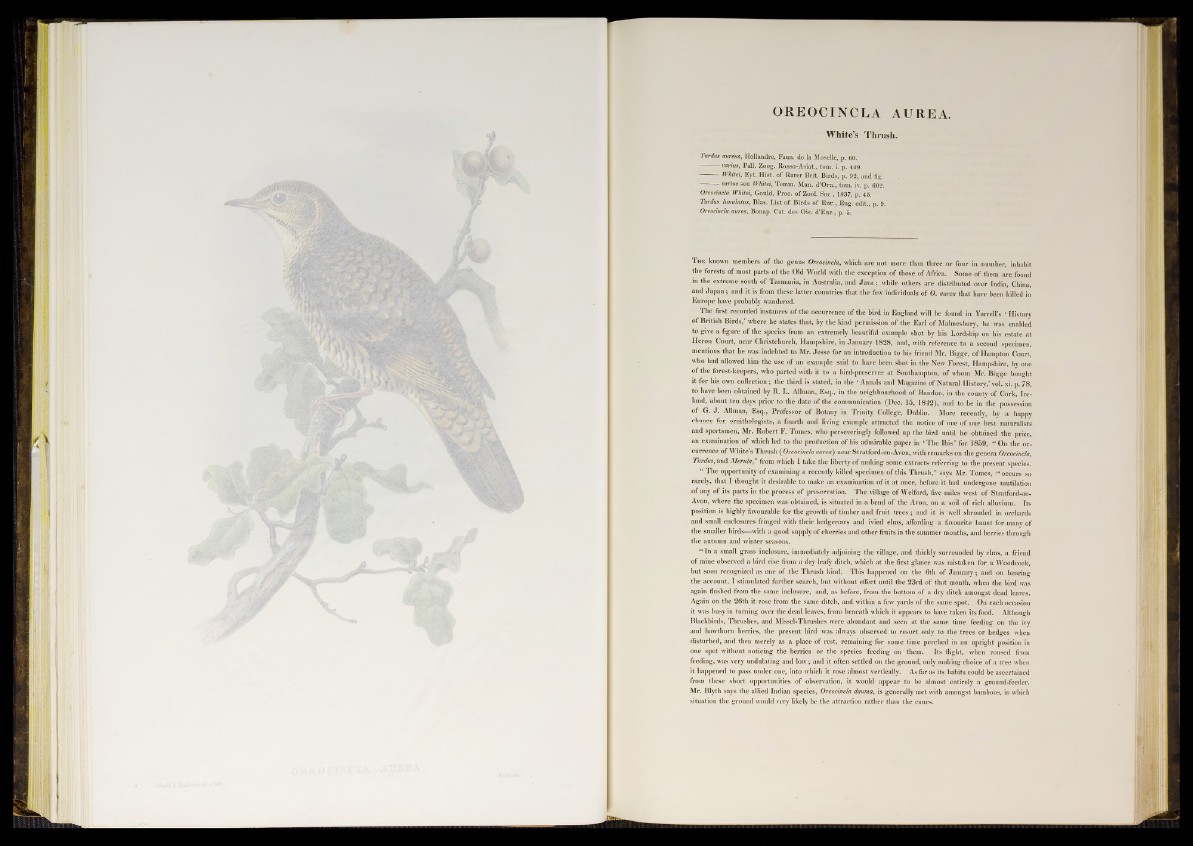
Pii
OREOCINCLA AUREA.
White’s Thrush.
Turdus aureus, Hollandre, Faun, de la Moselle, p. 60.
varius, Pall. Zoog. Rosso-Asiat., tom. i. p. 449.
Whitei, Eyt. Hist, of Rarer Brit. Birds, p. 92, and fi«\
—— - varius seu Whitei, Temm. Man. d’Om., tom. iv. p. 602.
Oreocincla Whitei, Gould, Proc. of Zool. Soc, 1837, p. 45.
Turdus lunulalus, Bias. List of Birds of Eur., Eng. edit., p. 9.
Oreocincla aurea, Bonap. Cat. des Ois. d’Eur., p. 5.
T h e known members o f the genus Oreocincla, which are not more than three or four in number, inhabit
the forests of most parts of the Old World with the exception of those of Africa. Some of them are found
in the extreme south o f Tasmania, in Australia, and J a v a ; while others are distributed over India, China,
and Ja p a n ; and it is from these latter countries that the few individuals of 0 . aurea that have been killed in
Europe have probably wandered.
The first recorded instances of the occurrence of the bird in England will be found in Yarrell’s ‘ History
o f British Birds,’ where he states that, by the kind permission o f the Earl of Malmesbury, he was enabled
to give a figure of the species from an extremely beautiful example shot by his Lordship on his estate at
Heron Court, near Christchurch, Hampshire, in January 1828, and, with reference to a second specimen,
mentions that he was indebted to Mr. Jesse for an introduction to his friend Mr. Bigge, o f Hampton Court,
who had allowed him the use o f an example said to have been shot in the New Forest, Hampshire, by one
of the forest-keepers, who parted with it to a bird-preserver a t Southampton, of whom Mr. Bigge bought
it for his own collection; the third is stated, in the ‘Annals and Magazine o f Natural History,’vol. xi. p. 78,
to have been obtained by R. L. Allman, Esq., in the neighbourhood o f Bandon, in the county of Cork, Ireland,
about ten days prior to the date of the communication (Dec. 15, 1842), and to be in the possession
of G. J . Allman, Esq., Professor of Botany in Trinity College, Dublin. More recently, by a happy
chance for ornithologists, a fourth and living example attracted the notice o f one o f our best naturalists
and sportsmen, Mr. Robert F. Tomes, who perseveringly followed up the bird until he obtained the prize,
an examination o f which led to the production of his admirable paper in ‘The Ib is’ for 1859, “ On the occurrence
of White’s Thrush (Oreocincla aurea) near Stratford-on-Avon, with remarks on the genera Oreocincla,
Turdus, and Merula,” from which I take the liberty o f making some extracts referring to the present species.
“ The opportunity of examining a recently killed specimen of this Thrush,” says Mr. Tomes, “ occurs so
rarely, that I thought it desirable to make an examination of it a t once, before it had undergone mutilation
o f any of its parts in the process of preservation. The village of Welford, five miles west of Stratford-on-
Avon, where the specimen was obtained, is situated in a bend of the Avon, on a soil o f rich alluvium. Its
position is highly favourable for the growth o f timber and fruit trees ; and it is well shrouded in orchards
and small enclosures fringed with their hedgerows and ivied elms, affording a favourite haunt for many of
the smaller birds—with a good supply of cherries and other fruits in the summer months, and berries through
the autumn and winter seasons.
“ In a small grass inclosure, immediately adjoining the village, and thickly surrounded by elms, a friend
of mine observed a bird rise from a dry leafy ditch, which a t the first glance was mistaken for a Woodcock,
but soon recognized as one of the Thrush kind. This happened on the 6th of Jan u ary ; and on hearing
the account, I stimulated further search, but without effect until the 23rd of that month, when the bird was
again flushed from the same inclosure, and, as before, from the bottom of a dry ditch amongst dead leaves.
Again on the 26th it rose from the same ditch, and within a few yards of the same spot. On each occasion
it was busy in turning over the dead leaves, from beneath which it appears to have taken its food. Although
Blackbirds, Thrushes, and Missel-Thrushes were abundant and seen at the same time feeding on the ivy
and hawthorn berries, the present bird was always observed to resort only to the trees or hedges when
disturbed, and then merely as a place of rest, remaining for some time perched in an upright position in
one spot without noticing the berries or the species feeding on them. Its flight, when roused from
feeding, was very undulating and low; and it often settled on the ground, only making choice of a tree when
it happened to pass under one, into which it rose almost vertically. As far as its habits could be ascertained
from these short opportunities of observation, it would appear to be almost entirely a ground-feeder.
Mr. Blyth says the allied Indian species, Oreocincla dauma, is generally met with amongst bamboos, in which
situation the ground would very likely be the attraction rather than the canes.